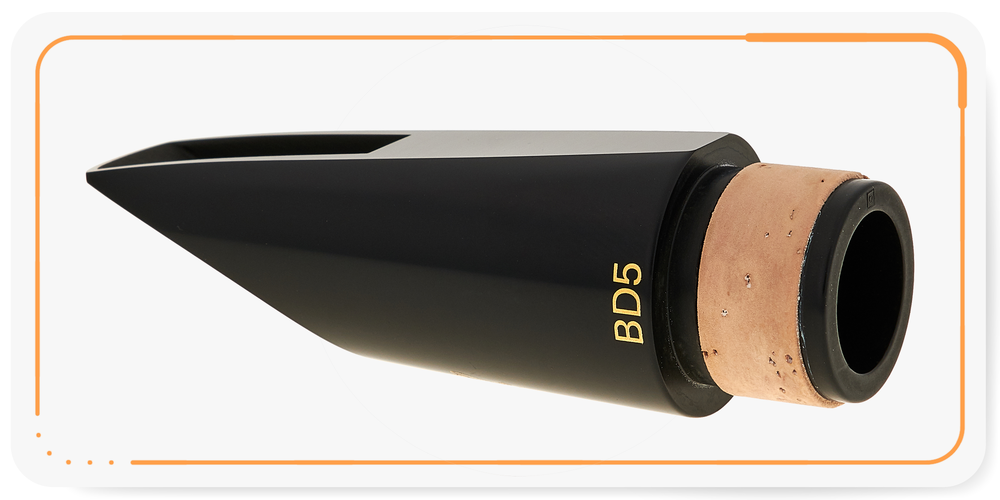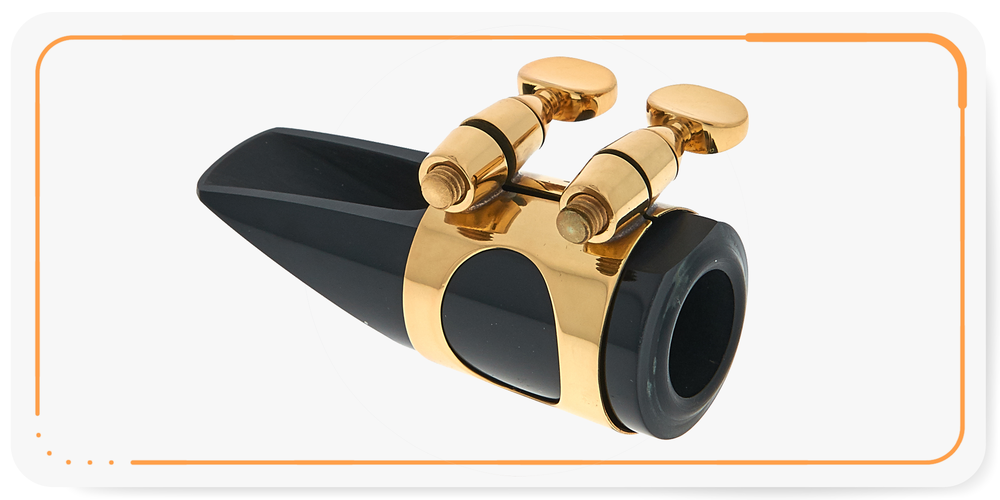4. Mouthpieces: clarinet and saxophone
Visually, the mouthpiece resembles that of a recorder. But instead of the labium (Latin for 'lip'), this mouthpiece features a simple reed attached to it. This reed is responsible for generating the sound.
Construction of the saxophone and clarinet mouthpieces
The explanation of the mouthpieces' construction goes downward from the upper area. The tip of the mouthpiece its most sensitive part. Handled with less than great care it can easily crack or chip. The opening at the top of the mouthpiece is called the window, and the area between the tip and the bottom of that window is called the facing curve. The distinctive features of the facing curve are the length and the tip opening. The length spans the entire surface covered by the reed from root to tip. The size of the opening denotes the distance between the tip and a straight reed.
The rails run along either side of the window and end in the table. The shank at the bottom is a major difference between the clarinet and saxophone mouthpieces: in clarinets, the cork-covered shank is stuck into the barrel joint. In saxophones, the mouthpieces are fixed to the instrument's neck, and the cork guaranteeing the best possible fit is part of the neck.
The opening through the mouthpiece is known as the bore. The type of bore distinguishes German and French clarinet mouthpieces. The latter has a wider bore and a shorter facing length in comparison to the former, which also means that different reeds have to be used.
If you're in a position to choose, it's the material that counts
Clarinet mouthpieces
Clarinet mouthpieces are available in a wide variety of mouthpieces. The most common is natural rubber.
Experts, however, refer to ebonite rather than natural rubber. This material covers the entire range of sound on offer, with the soft wooden sound being preferred with the clarinet.

Ebonite
Some companies offer truly eye-catching mouthpieces made from crystal. Now, if you think such a mouthpiece would break immediately on impact should it fall, let's be clear: a drop from any distance is bad for any mouthpiece - if it lands at an unfortunate angle, it chips easily. As far as sound is concerned, that of crystal mouthpieces is brilliant, a little bit louder and more piercing than that of ebonite mouthpieces.

Crystal
Wooden mouthpieces are found more rarely but they excellently support the clarinet's warm sound. Grenadilla wood and ebony are the preferred materials here.
Budget mouthpieces are made of plastic. As far as the sound goes, they are not really everything a clarinet could wish for. They can sound shrill, plasticky, especially in the upper ranges. But they are particularly easy to maintain, and the main question, of course, is what I want to use the mouthpiece for.
When you ponder the question of how the material impacts the sound of your clarinet,it is important to keep in mind that many aspects play a part. One and the same mouthpiece can generate a new and different sound when using a soft rather than a hard reed. But more on that in the section on reeds.
Saxophone mouthpieces
The saxophone mouthpiece's structure was discussed together with that of the clarinet mouthpiece. With the saxophone even more than with the clarinet, it is important the the sound be just right. Thanks to the wide variety of musical uses, there is an equally wide range of possible sounds. But there are common, aspects, too: as with the clarinet, saxophone mouthpieces are made from a plethora of materials.

Stainless Steel
Most saxophone mouthpieces, too, are made of natural rubber.but they are not all equal as far as their sound is concerned. There are rubber mouthpieces for classical and jazz music, mouthpieces which create a soft sound, almost like the sound of string instruments and those that create a strong piercing sound. Besides rubber, metal is also a frequently used material.

Natural rubber
Metal mouthpieces may be made from brass, bronze, steel or special alloys. Though there are metal mouthpieces explicitly advertised as suitable for classical music, they are generally preferred by jazz and rock musicians. If you like your sound a little rough, you'll love a metal mouthpiece! It is also important to note that metal mouthpieces offer a bit more bang for your buck than rubber mouthpieces. Metal's advantages are interesting for tenor or baritone mouthpieces: They can be very slim thanks to the material's hardness. If you were to build a mouthpiece to exactly the same specifications from metal and from rubber, the metal one would sound somewhat more brilliant than its rubber counterpart.






